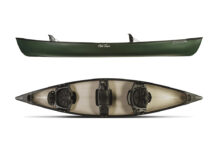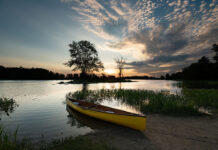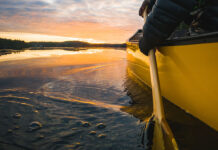Many paddlers will remember the loss of venerable canoe brands Scott Canoe and Bluewater Canoe when parent company Mid-Canada Fiberglass went belly up and closed its doors in 2013. Well, Bluewater’s Saugeen fleet lives again in the Abitibi Saugeen canoe.
Abitibi Saugeen 16.6 Specs
Length: 16’6”
Width: 35”
Weight: 50 lbs
Capacity: 350-550 lbs
MSRP: $3,299 CAD
In early 2015, a pair of young Quebecois men, Guillaume LeBlanc and JD Petite, purchased the precious Mid-Canada moulds and assets—including the Saugeen—and formed the new Abitibi & Co. canoe company. Now entering its third year of operation, Abitibi & Co. is re-issuing classic designs from Bluewater and Scott with a modern flair—and they look better than ever.
Taking the Saugeen for a spin
Last fall, I had the opportunity to test a shiny new 16.5-foot Abitibi Saugeen, the mid-size version of the three Saugeens available once again.
Unable to travel far from home on a sunny September weekend, my partner, Geoff, and I added a bike shuttle twist to a local lazy river we’ve paddled a dozen times.
For the first 20 kilometers of our adventure, our sunny Saugeen was simply baggage, cradled gently by a canoe cart on loan from Wike Trailers.
The Saugeen trundled along behind us without complaint, our paddles gently ratatat-ing against its interior.
Ferry a heavy load
Midday found us riverside, disassembling our bikes and Tetris-ing them into the hull, taking care with derailleurs, and trying to slide frames under thwart or yoke. We were pleased to find two paddlers, two touring bikes, panniers, canoe cart and a backpack could fit inside the Saugeen’s beamy 35-inch wide hull just fine. On the water, the combined weight of paddlers and gear must have been approaching the Saugeen’s recommended max carrying capacity of 540 pounds.
With some of our awkward load riding high above the gunwales, we were always stable—even in swifts. An inch of rocker in the Saugeen’s profile creates enough maneuverability for tracing sharp bends in the shoreline and avoiding the odd downed tree, while maintaining excellent tracking.
At the end of 30 kilometers of twists and turns, I was sold.
Tandem or solo, the Saugeen 16.6 does both
The Abitibi Saugeen offers great versatility in an all-round package. I can understand why the design was one of Bluewater’s most popular traditionally shaped boats. The Saugeen is ideal for someone who does a little bit of a lot different things on the water, including wanting a tandem canoe offering solid solo performance.
I put this theory to the test a few weeks later on a solo, meandering creek excursion. Then we took the Saugeen out on a portage-heavy weekend trip, and on Christmas Day for a merry spin on a frigid ice-choked lake. It’s a friendly boat. Even on the 1000-meter-long portage from my house to the lake, the Saugeen’s 50 pounds rode easy thanks to a deep-dish ash yoke, which balanced well on my shoulders.
The cheery canary yellow exterior looks smart paired with the standard black anodized aluminum gunwales. Webbed seats, ash carry handles and thwarts, and protective composite skid plates round out the package. Vinyl and ash are trim options Abitibi & Co. also offers.
True to the original design, our Saugeen features a keel. The keel is primarily to protect the canoe against grounding, according to Abitibi & Co. “On a flat-bottomed boat, a keel will be damaged first and protect the rest,” adds LeBlanc.
Canadian-made with style and flair
Our Saugeen came to us straight from the manufacturing headquarters in Rouyn Noranda, Quebec, just inside the Quebec-Ontario border. Five years ago Guillaume LeBlanc was a paddling enthusiast and mechanical engineer looking for a career change. When he contacted Mid-Canada Fiberglass he was hoping to assist with reinvigorating their failing canoe brands. Instead he wound up purchasing their assets and molds with business partner and marketer JD Petit.
Marketing flair is visible in Abitibi & Co.’s attention to aesthetic in its boats, website and catalogs. Their moody and evocative images drip Instagram fame. The brand also produces an outdoor lifestyle magazine, Beside, and manufactures a line of heritage-inspired hand-painted canoes in collaboration with Montreal-based paddle maker Norquay.
“People talk about the features of a canoe—the weight and length—but they buy one because of the feeling they want to get in it,” says LeBlanc.
From products to digital properties, the Abitibi & Co. strategy is to stir up our wanderlust, transmuting what were utilitarian and purpose-driven canoe designs in the hands of Bluewater and Scott into art and inspiration on water. It’s kind of their thing.
When we took over production, we changed
the branding, layups, colors, finish and design
From the 100 or so Mid-Canada Fiberglass molds available when LeBlanc and Petit purchased the assets, Abitibi & Co. is now only manufacturing three-dozen canoe designs, including Bluewater’s Scout and Tripper, as well as 16-foot versions of the Peterborough and Prospector.
Abitibi & Co. bring start-up energy to the Saugeen
Despite building on the decades-long history of the canoe moulds and the Bluewater and Scott brand names, LeBlanc says Abitibi & Co. still feels a lot like a start-up.
“When we took over production, we changed the branding, layups, colors, finish and design,” says LeBlanc. The brands had 50 years of production behind them, but they were stagnant over the last 10 years, and so there was 10 years of catch-up to do while taking back production.
Color schemes have been updated and are more varied. Abitibi & Co’s construction process reflects sustainable and environmentally-friendly best practices. Like Bluewater before them, Abitibi & Co. offers the Saugeens in a Kevlar layup. Resin is infused into the fabric via vacuum bagging, then a gelcoat is applied.
“Without the gelcoat, you have a light boat but there is no repairability. We always want to be able to repair, so all our boats have gelcoat,” says LeBlanc. At 50 pounds and 16.5 feet, our loaner Abitibi Saugeen is not the heaviest or the lightest Kevlar canoe on the market. “We’re hoping to hit a sweet spot and make boats which will last for forever,” says LeBlanc.
This article was first published in Issue 53 of Paddling Magazine. Subscribe to Paddling Magazine’s print and digital editions, or browse the archives.








